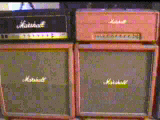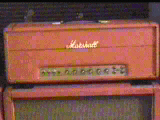teacher Wolf Marshall

lv8rdoc:
Nice intro teach!
Wolf Marshall:
LV, thanks. Those are the beginnings of heavy metal.
Ok we're going to send some music ---coming up. This first one is a good demo of that Marshall tone and use of blues licks over a hard rock progression
Wolf Marshall:
This is how hard rock got started --from British blues rock
JOEYC:
totally Cream/Clapton
KEV:
so what's up w lick 1
Tom:
sounds like a clapton lick
Wolf Marshall:
About the music---that's a relatively common blues line--but over the Mixo chords: C-G-D,
You guys have ears of gold... Play it with these chords-- and it changes the whole character.
ginnym:
That is great stuff - like Vanilla Fudge even !
Wolf Marshall:
You guys, the idea is to play blues licks against alternate chords and new feels.
The lick is straight D minor pentatonic but the chords change its sound.
howlin:
blues licks out of the "standard blues boxes"?
Wolf Marshall:
Yeah, howlin
dgguitar:
And the JAM what chords?
Wolf Marshall:
Cmaj-G/B and D, DG... AC/DC, and Journey are two other bands that have used this idea.
JOEYC:
AC/DC is STILL using that idea!!!!
Wolf Marshall:
You got it, Joey, It's a very useful concept--that came from EC
JOEYC:
renewing your roots is so important
Wolf Marshall:
it keeps you pure
Wolf Marshall:
so far both are in D---but two different scales, it is in D Mixolydian using D major pent and blues notes mixed
howlin:
I like how this is taking stuff I already know and using it in new ways...
JOEYC:
you are making us all better players by reviewing all this history
Wolf Marshall:
I hope it helps, To all, notice how the two different scales can be played over the same chords.
The minor pentatonic is harder, the major is sweeter. Here come some family photos.
WOLF'S FAVORITE MARSHALLS

Wolf Marshall: Completely original, though well-used, 1970 red Marshall stack. These were the first custom color red Marshalls brought to the U.S.! Red levant covring, Grey Basket Weave grill cloth (a.k.a. "Salt and Pepper"). The JCM-800 head is my favorite master-volume head: a 1983 100-watt Lead model.
Wolf's red Marshall head

Wolf Marshall: A closeup of the red head. This is Non-master 100-watt Super Bass head. Front panel from left to right: Polarity switch, On-Off switch, Standby switch, pilot light, Presence control, Bass control, Middle control, Treble control, Volume I, Volume II, High and low sensitivity inputs for Channel I, High and low sensitivity inputs for Channel II.
Wolf's blues-rock axes

Wolf Marshall: Background: 1970 red Marshall stack. JCM-800 head (left). Foreground, Left to Right: white Fender Stratocaster, Fuzz Face, and Gibson Les Paul Standard.
Here comes the third lick!
gman:
cool lick, very Page sounding
Wolf Marshall:
Gman, that's it. Page was the final link between British Blues and Metal
ginnym:
Wolf? this jam is working in E pentatonic? correct?
Wolf Marshall:
The groove is a heavy slow boogie. The lick is in E Mixolydian Mode.
Wolf Marshall:
Note that major sound over the blues-metal boogie. The lick has a bit of echo,
the bends in the lick are typically Pagey.
Steve:
who is Page's main influence?
Wolf Marshall:
Steve, Buddy Guy , BB King, Les Paul, Scotty Moore...
Wolf's Fuzz Face

Wolf Marshall: This is the pedal favored by Jimi Hendrix when playing a Strat through non-master-volume Marshalls. Also used by David Gilmour, Eric Johnson and many others. Controls are Volume and Fuzz (eyes), On-Off effect switch (nose). The originals were made in England in the 1960s. They are currently reissued by Jim Dunlop.
JOEYC:
aah the Fuzz Face..I'm 13 again!!!
Wolf Marshall:
The Fuzz Faced is a wonderful unit. Seriously, the Fuzz Face is great with a Strat--good combo.
I need the right gear especially for duplicating various players in my gig. Here comes another lick
Tom:
this one looks pretty heavy
Wolf Marshall:
Yes, jug, this lick is a bit more technical, Notice the use of blues scale and major pentatonic
Allen:
Is there triplets in the lick?
Wolf Marshall:
Allen, 32nd notes, it's in a triplet feel---12/8 time.
jugulug:
do you use harmony and scales outside the diatonic ,blues and pent scales?
Wolf Marshall:
Jug, sure with discretion
Jeff:
isn't that using modes of the scale your using Wolf...?
Wolf Marshall:
Not always, Jeff. Blue notes are chromatic departures. Like in this lick, G and G sharp
also B and B flat
jugulug:
i got exited about tritone theory lately and using it in I, IV, V progs
Jeff:
more intervals then.....thats how I am seeing it now..
Wolf Marshall:
Jug, the tritone is the basis for the blues scale
Allen:
I wish the last bend would just go on until it dies naturally.
jugulug:
you don't view the pentatonic as the basis of the blues scale?
Wolf Marshall:
When blues became metal more scale combining ensued. The tritone is what makes the diff, jug
jugulug:
you mean that slightly out there b5 effect?
Wolf Marshall:
Without the tritone the minor pentatonic is not spicy, Jug, I mean the essential flat 5
and major pentatonic is too pretty
jugulug:
b5 of the chord you're on?
Wolf Marshall:
The flat 5 interval used strategically, Jug, thanks everyone. I'll see you all next week for the next episode.
|
<< load notation from left
|